3D-LINE on Combining Concrete and Plastic 3D Printing for Design and Architecture
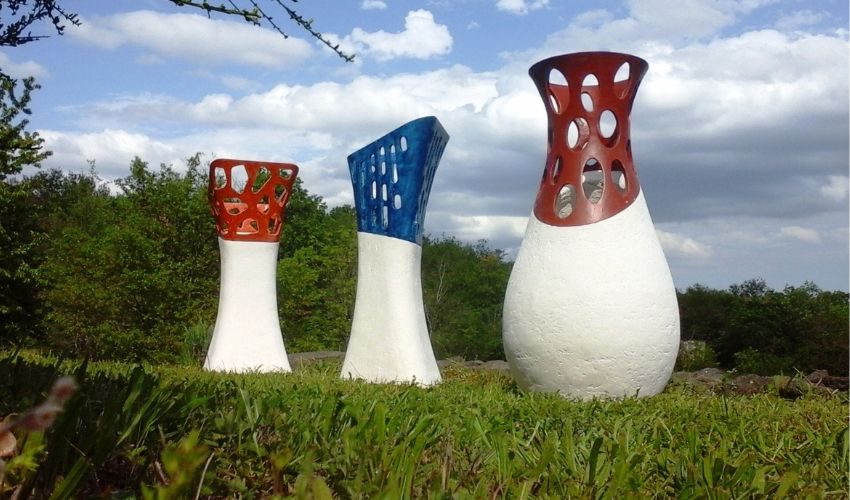
There are a number of players in the concrete 3D printing field, particularly in the renewable energies sector. Among them is 3D-LINE. This is a brand of the company V-Concept, founded in 2017. It specializes in concrete and plastic 3D printing for the design, furniture and architecture sectors. We sat down with Frédéric Vigier, the President, to learn more about the specifics of the brand, including the particularities of its concrete 3D printing processes and how it articulates this with plastic 3D printing. Frédéric Vigier also told us about the different stages in the manufacture of 3D-LINE’s large decorative vases, as well as other use cases for its technologies.
3DN: Could you introduce yourself and your connection with 3D printing?
I have over 20 years’ experience in the plastics industry, where I acquired in-depth expertise in plastic injection molding. Over the years, I have specialized in industrialization and product development, while nurturing a creative passion for creating new things.
As early as 2005-2006, plastic 3D printing caught my attention as a technology heralded as a real revolution. Later, one of my objectives was to use 3D printing to produce large parts in small batches, and to achieve this, I sought to optimize productivity and cost price by using assemblies of plastic resins and mineral fillers within my own structure. Along the way, I decided to replace the resin with cement. This was in 2016 and concrete 3D printing was not sufficiently developed, so I embarked on an exciting journey where I had to build everything, to bring this vision to life.
My relationship with 3D printing stems from my long-standing background in plastics processing, combined with my passion for innovation and my desire to push back the boundaries. I see concrete 3D printing as a formidable challenge, which pushes me to explore new perspectives and open up unprecedented opportunities in the field of manufacturing.
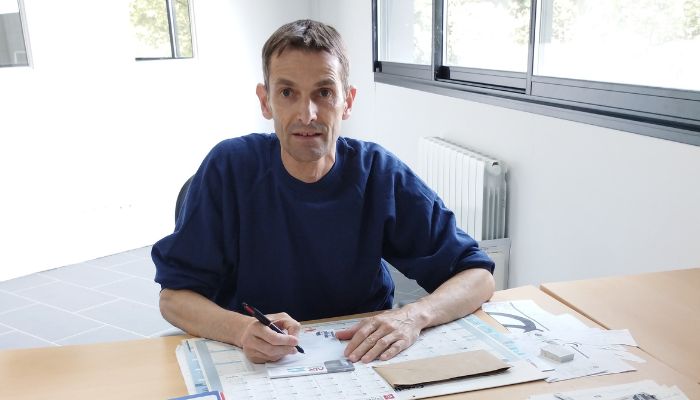
Frédéric Vigier, head of 3D-LINE
3DN: How did 3D-LINE come about and what is your mission?
3D-LINE was born of my passion for 3D printing and my desire to explore the potential of concrete in furniture design. Our core business at 3D-LINE is designing and producing concrete furniture, made using 3D printing. Our product range includes planters, vases and garden pots, as well as benches, decorative elements and garden lamps. Our customers are mainly designers, architects and discerning individuals looking for original pieces in small series.
The development of the brand is the fruit of a complete design and production process. I put a lot of effort into developing my 3D printer from A to Z, taking charge of the design, production, programming, algorithms and associated software. At the same time, I developed specific formulas adapted to concrete to guarantee optimum performance in furniture production.
By choosing the name “3D-LINE” for my own product line, I wanted to underline my commitment to 3D printing. As we specialize in garden furniture, we enjoy greater creative freedom, as this sector is less regulated and standardized than the traditional construction industry, which is the outlet for the sector’s trades. This allows us to explore new shapes, push back the boundaries of design and produce more complex pieces as we evolve.
As our printer becomes more and more powerful, we are able to produce even more complex parts. This creates a virtuous circle where our technical development feeds our ability to design innovative parts and satisfy our customers’ needs and requirements. At 3D-LINE, we are constantly on the lookout for new technical and aesthetic advances to offer our customers unique and inspiring creations.
3DN: Could you describe the steps involved in making a vase?
It all starts with working closely with the customer to precisely define their functional needs and aesthetic preferences, including desired shapes, colors and textures. Once these elements have been clarified, I start by sketching a few ideas on paper, giving me an 80% vision of the final piece. Then I move on to 3D modeling to bring these concepts to life.
To validate the design with the customer, I always make a 1/10 scale plastic model. This step is essential to enable the customer to visualize the shape concretely, and to ensure that his expectations are fully met. Once we’ve validated the final design, we’re ready to move on to the concrete printing phase.
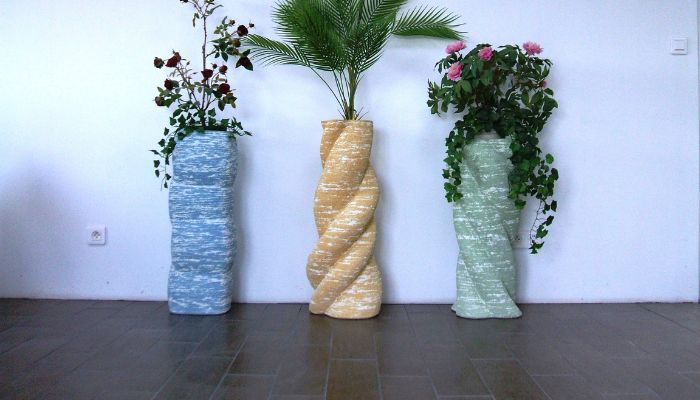
Concrete vases made by 3D-LINE
Printing the concrete vase is a relatively quick process, and programming and manufacturing are often quicker than making the model itself! After that, we enter a crucial period of concrete strength build-up. The part is placed in a controlled environment in terms of temperature and humidity, where it is left for a period of 14 days. This stage is vital to guarantee the vase’s strength and durability.
Once this period has elapsed, we move on to the finishing stage. This includes sanding to obtain a smoother surface, as well as engraving or any other personalization treatment requested by the customer. Finally, we apply a protective treatment to preserve the vase’s integrity and appearance, ensuring a long service life.
Once these steps have been completed, the vase is ready to be shipped to the customer. We take pride in creating unique, high-quality vases that meet the expectations of our most demanding customers.
3DN: How does your technology compare with other concrete 3D printing technologies?
Simplicity of use and maintenance: Our machine is designed to be easy to use, whether during operation or cleaning. What’s more, staff training is fast, making for easy integration. Another advantage is our ability to suspend printing and resume it without problem, even after interruptions of up to 5 or 10 minutes. This flexibility also enables us to place inserts at different points in the part.
Varied choice of materials: We offer a wide range of concretes adapted to different uses and mechanical constraints. From basic to technical cements, we can meet the specific needs of every project. We are also aware of the importance of environmental impact, which is why we even offer ultra-low-carbon cements, offering a more environmentally-friendly alternative.
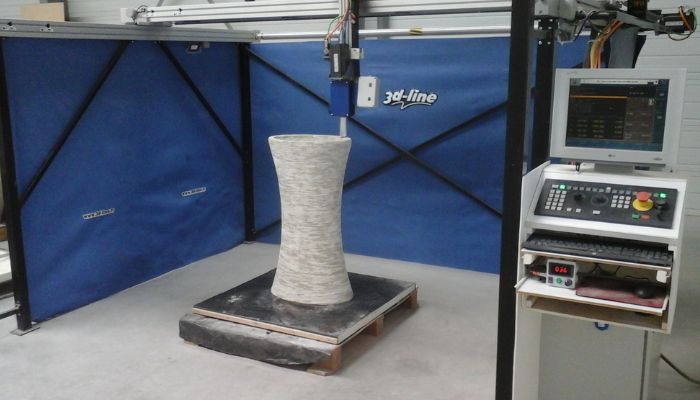
A vase in the process of being printed
Continuous fiber reinforcement: Our co-extrusion system enables continuous carbon or glass fibers to be added to the printing process, directly into the extrusion nozzle. This technique guarantees greater strength in the final parts, compared with short fibers mixed in the traditional concrete mixer. The result is much stronger, more durable parts.
Superior quality and finish: We pride ourselves on the quality of our products’ manufacture and finish. Our technology enables us to produce parts with high precision and consistency, qualities that are recognized by all our partners.
3DN: How do plastic and concrete 3D printing fit together at 3D-LINE?
Our approach to plastic 3D printing is closely integrated with our concrete 3D printing business. We capitalize on the synergies between these two fields. The digital tools we use are the same, and the techniques employed are similar, even if the materials are different.
To optimize productivity, we use standard machines modified by us. Overall, the print heads are larger and more powerful. These adaptations enable us to achieve superior performance. The plastic and concrete parts are developed by the same person. This minimizes errors and loss of time or information. What’s more, we make the plastic part before the concrete one. This allows us to “blank-fit” the plastic part to the still-fresh concrete, for perfect results.
By combining the two technologies, we are able to offer unique products that integrate the advantages of each material. For example, we can use plastic 3D printing to create complex, detailed and lightweight elements, which can then be assembled with more massive concrete components. This combination opens up wider possibilities in terms of design and functionality.
3DN: Could you give us a few examples of how 3D-LINE’s technology is used?
We’re currently working on the creation of entrance hall furniture. The weight of the concrete part provides the stability needed for a high-traffic area with a remarkable mineral touch, while the plastic parts are used for elements with a finer design at height, as well as for storage units – in other words, for all high, non-fixed-to-the-ground pieces in areas where there’s a risk of jostling, such as stores or leisure parks. And of course, the combination of the 2 materials: mineral and synthetic, allows you to take advantage of the remarkable textures and reflections generated.
We can produce architectural elements such as facades, columns, balustrades and much more. These elements can be integrated into residential or commercial construction projects, adding a unique, modern touch to the overall aesthetic while ensuring long-term durability. Our technology also enables artists to bring their creative visions to life by producing personalized works of art in concrete.
These examples illustrate the versatility of our concrete 3D printing technology and its potential to meet the specific needs of artistic, architectural and urban planning projects. We are constantly open to new challenges and are delighted to collaborate with our customers to realize their boldest ideas.
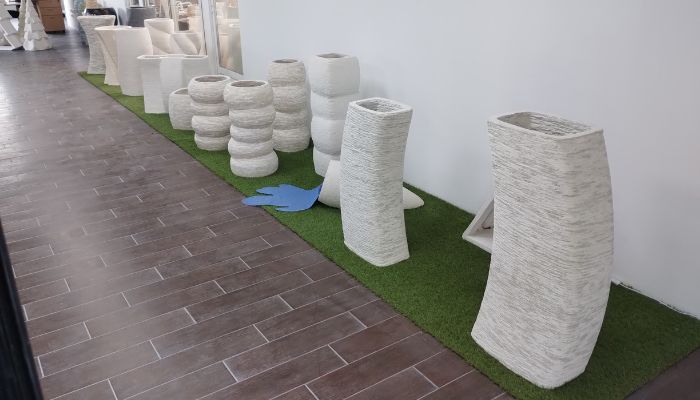
Concrete vases stored at 3D-LINE
3DN: Could you tell us about 3D-LINE’s upcoming projects?
The most important is to further develop our business, raise awareness and inform designers and architects who have not yet taken on board the possibilities offered by 3D concrete printing on a daily basis. We firmly believe that this technology can transform the way architectural and design projects are approached.
Furthermore, we are currently undergoing studies on carbon-fiber-reinforced staircases: One of our projects involves the manufacture of carbon-fiber-reinforced staircases. We are able to create staircases with greater strength than those with traditional metal frames, while reducing their weight by almost 60%. But for now, it remains a secret…
We are constantly looking for new opportunities to apply our 3D concrete printing technology. Whether in residential, commercial or public architecture, we are determined to explore new horizons. We are open to collaborating with innovative partners to develop bespoke products, architectural elements or artistic pieces that meet the specific needs of each project.
3DN Any last words for our readers?
We’re passionate about pushing boundaries, defying convention and bringing bold ideas to life. We invite you to visit our website. There you’ll discover a world where creativity meets technology, where concrete becomes a canvas for expressing unprecedented shapes and textures.
Whether you’re an architect in search of innovation, a designer looking for new horizons, or simply curious and eager to discover new things, we’d be delighted to help you with your project. Contact us to discuss your ideas, challenges and wildest dreams.
What do you think of 3D-LINE? Let us know in a comment below or on our LinkedIn, Facebook, and Twitter pages! Don’t forget to sign up for our free weekly newsletter here, the latest 3D printing news straight to your inbox! You can also find all our videos on our YouTube channel.
*All Photo Credits: 3D-LINE







